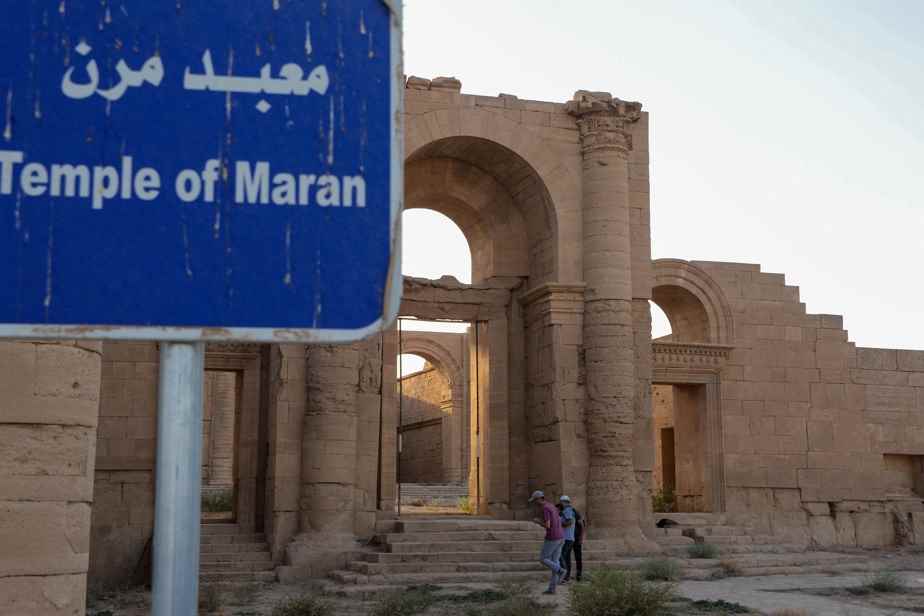(Hatra) Strolling among the 2,000-year-old ruins, dozens of visitors admire the ancient city of Hatra, in northern Iraq, where local initiatives are timidly seeking to encourage tourism and turn the page on jihadist abuses.
Posted at 10:06 a.m.
Built in IIe or IIIe century BC, the site of Hatra, listed as a UNESCO World Heritage Site, is a two-hour drive from Mosul, the former “capital” of the Islamic State (IS) group, reconquered in 2017 by Iraqi forces and an international coalition.
The unprecedented excursion, organized on Saturday by a private museum in Mosul, allowed around forty mainly Iraqi visitors to stroll in the golden light of twilight on the archaeological site.
In front of imposing colonnades topped with Corinthian capitals, tourists take selfiesexamine wall reliefs ransacked by jihadists.
“It is the place of an ancient civilization. We feel not only ancient history, but also the events of the past years, with the EI”, confides to AFP Luna Batota, a 33-year-old Iraqi woman who came with her Belgian husband.
The young woman has lived since the age of nine in Belgium. It is his first visit in 24 years to his native Iraq.
In Hatra, she evokes “mixed feelings: we still see bullet holes, empty bullet cartridges”.
An important religious and commercial center under the Persian Empire of the Parthians, the city of Hatra was endowed with imposing fortifications and housed magnificent temples, combining Greek and Roman architecture with decorative elements of Eastern origin.
In 2015, IS released a video showing its fighters destroying wall reliefs there, shooting them and attacking a statue with a pickaxe.
Last February, the authorities unveiled three restored sculptures on the site: a life-size bust of Roman inspiration, but also faces carved on the wall of the great temple.
“Full of tourists”

PHOTO ZAID AL-OBEIDI, AGENCE FRANCE-PRESSE
A group of tourists visit the ancient city of Hatra
Five years after the rout of IS, Mosul and its surroundings are regaining a semblance of normality, even if reconstruction is suffering from slowness and the cities still show the scars of the destructive fighting that made it possible to drive out the jihadists.
Saturday’s excursion to Hatra is the first of its kind organized by the Mosul Heritage House, a private museum inaugurated in mid-June. But the site already attracts individual tourists, especially locals, recognizes one of the organizers, Fares Abdel Sattar, a 60-year-old engineer.
The objective of the initiative: “to highlight the heritage and identity” of Mosul and its region of Nineveh, he said. But also to make it “a tourist region, given the great economic and cultural benefits”.
After its rise in power in 2014 and the conquest of vast territories in Iraq and Syria, the IS was routed by several offensives in these two countries. Iraqi forces declared victory at the end of 2017.
And in an Iraq which is slowly opening up to world tourism and which is already benefiting from religious tourism in the holy Shiite cities of Karbala and Najaf, the authorities are aware of the economic windfall available to them.
However, the challenges abound and the tourist infrastructures represent a titanic project for a country rich in oil, but ravaged by decades of war. It is necessary to build hotels, even rest areas on the sites.
“Mosul is not just war, IS and terrorism,” raves Hatra Beriar Bahaa al-Din, a doctoral student in anthropology at the British University of Exeter. “Mosul is a civilization, a heritage, a culture. »
“Today I came to see this culture,” says the 29-year-old visitor. But he says he feels a certain “sadness”, acknowledging that access to Hatra remains difficult, while deploring the absence of explanatory panels telling the history of the site.
“This imposing site should be filled with tourists from all over the world,” he said.
